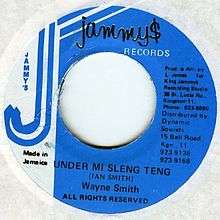Sleng Teng
| "Under Mi Sleng Teng" | ||||
|---|---|---|---|---|
 | ||||
| Single by Wayne Smith | ||||
| from the album Sleng Teng | ||||
| Released | 1985 | |||
| Format | 12" | |||
| Genre | Reggae, Dancehall | |||
| Length | 4:06 | |||
| Label | Jammy's/Greensleeves | |||
| Producer(s) | Prince Jammy | |||
| Wayne Smith singles chronology | ||||
| ||||
Sleng Teng is the name given to one of the first fully computerized riddims, influential in Jamaican music. The riddim, which was created by the collaboration between King Jammy and Wayne Smith, was titled "Under Mi Sleng Teng" in 1984. Wayne Smith found the computerized sound in Noel Davey's keyboard, and together he and Davey arranged the riddim, slowed it down, matched it to Smith's key, and rehearsed on it with lyrics inspired by Barrington Levy's "Under Mi Sensi" and Yellowman's "Under me fat ting",[1] before taking it to Jammy's studio in late 1984.[2] The riddim itself is apparently an attempt to recreate Eddie Cochran's 1959 rockabilly song "Somethin' Else." It is a pattern found in the Casio MT-40 home keyboard.[1][2][3] However, the pattern's creator, Casio's Product Development and Music Engineer Hiroko Okuda has denied this as the source, saying instead that it was based on a 1970s British rock song she declined to identify,[4] but has been suspected to be the David Bowie song "Hang On to Yourself".[5]
After the riddim was brought to the studio and Jammy heard it, he then slowed it further and placed piano and a clap on it.[2][3] Jammy recorded a number of other artists on the original backing track including Tenor Saw (with "Pumpkin Belly"), and Johnny Osbourne (with "Buddy Bye"). The tunes were first unleashed at a now legendary soundclash between Jammy's own sound system and Black Scorpio at Waltham Park Road on February 23, 1985.
Some of Jammy's productions based on the rhythm were released on the albums Sleng Teng Extravaganza and Sleng Teng Extravaganza 95.[3]
Influence
Scholars Peter Manuel and Wayne Marshall argue that Sleng Teng "was seminal in various ways ... [it] further consolidated the trend toward the new production of riddims based on short ostinatos, rather than reliance on vintage B-side tracks, with their occasionally problematic chord progressions". Secondly, its sounded thoroughly novel and different from the "overused Studio One classics". Third, its success promoted the wide use of digital production methods, where "a keyboard synthesizer, sequencer, and drum machine, or access to these, could generate a new riddim, without having to spend money on studio time or studio musicians".[1]
Sleng Teng is among the most versioned (rerecorded) of Jamaican riddims, listing around 380 versions.[6] The riddim was updated by Jammy in 2005 (slightly speeded up, with added horn riff) and this variation is known as "Sleng Teng Resurrection." Several new cuts on the original Sleng Teng were also released by Jammys in 2005 in celebration of the riddim's 20th anniversary.
King Tubby, who had originally taught Jammy how to produce music, was inspired by the track to create his own "Tempo" riddim.
Jammy recorded a number of other artists aside from wayne smith on the original backing track artists including Tenor Saw (with "Pumpkin Belly"), and Johnny Osbourne (with "Buddy Bye").
SL2 sampled the bass line for their UK hit rave track "Way in my brain".[7]
The electronic duo Discovery uses a similar musical style in "Slang Tang" from their album LP in a nod to Sleng Teng.[8]
British musician M.I.A. references Sleng Teng in the track "Pull Up the People" on her album Arular.
The song is also used in the promotional trailer on Channel 4 for This Is England '86.
The bass line of "Caress Me Down" by notable reggae rock group Sublime features the famous Sleng Teng riddim from Wayne Smith's 1985 song "Under Me Sleng Teng"
Electronic artist Robyn references Sleng Teng in the track "Dancehall Queen" on her album Body Talk.
Notable reggae/dancehall kings Super Cat, Ninjaman, and Yellowman, as well as many more have sampled their own versions of the Sleng Teng riddim.
311 also quote the lyrics in their song "Who's Got the Herb".
Hip-hop group Cypress Hill recorded a cover version of this song with them providing new verses of rap.
The electronic reggae dub based band Tatanka (Denver, CO) has also used the riddim and rewrote and re played the instruments as well as new lryics for a new twist of their own version of Sleng Teng called "Show me love" as well as a instrumental dub version of the track.
References
- 1 2 3 Manuel, P. & Marshal, W. "The Riddim Method: Aesthetics, Practice, and Ownership in Jamaican Dancehall." Popular Music (2006) 25:3. Cambridge University Press, pp. 447–470 http://wayneandwax.com/academic/manuel-marshall_riddim-method.pdf
- 1 2 3 Katz, David (2014) "Wayne Smith's Under Mi Sleng Teng – the song that revolutionised reggae", The Guardian, 20 February 2014. Retrieved 23 February 2014
- 1 2 3 Cooke, Mel (2015) "30 Years Of Sleng Teng - King Jammy Recalls Impact Of Digital Breakthrough", Jamaica Gleaner, 12 April 2015. Retrieved 12 April 2015
- ↑ Trew, James. "How Casio accidentally started reggae's digital revolution". Engadget. AOL Tech. Retrieved 5 December 2015.
- ↑ "David Bowie: Father Of The Sleng Teng Riddim". Axis Chemicals. Retrieved 12 January 2016.
- ↑ Frenkieh Riddim Database 2011, Sleng Teng Riddim (1985), page 10 (361 - 380) http://riddims.frenkieh.com/show/riddims/18/page_10/
- ↑ Colin Larkin: The Encyclopedia of Popular Music, Volume 7. Oxford University Press, USA, Nov 20, 2006, p. 515 ("The b-side 'Way In My Brain' employed the reggae bass line of 'Under Me[sic] Sleng Teng'...")
- ↑ Yodice, Kristopher (May 31, 2012). "An Interview With Discovery We Never Printed". Death and Taxes. Archived from the original on July 23, 2012. Retrieved July 23, 2012.
External links
- Sleng Teng Riddim at Frenkieh.com Riddim Database
- Sleng Teng Riddim at riddimguide.com
- Wayne Smith's Under Mi Sleng Teng – the song that revolutionised reggae